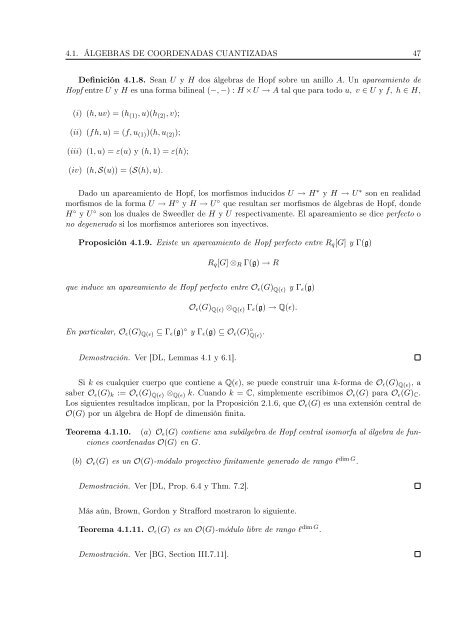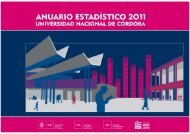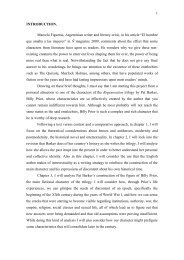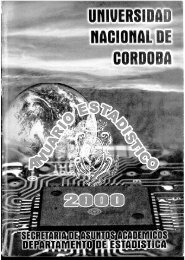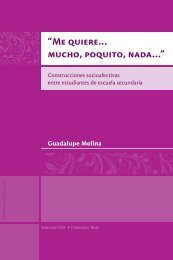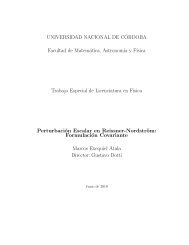Abrir - RDU - Universidad Nacional de Córdoba
Abrir - RDU - Universidad Nacional de Córdoba
Abrir - RDU - Universidad Nacional de Córdoba
You also want an ePaper? Increase the reach of your titles
YUMPU automatically turns print PDFs into web optimized ePapers that Google loves.
4.1. ÁLGEBRAS DE COORDENADAS CUANTIZADAS 47<br />
Definición 4.1.8. Sean U y H dos álgebras <strong>de</strong> Hopf sobre un anillo A. Un apareamiento <strong>de</strong><br />
Hopf entre U y H es una forma bilineal (−, −) : H ×U → A tal que para todo u, v ∈ U y f, h ∈ H,<br />
(i) (h, uv) = (h (1) , u)(h (2) , v);<br />
(ii) (fh, u) = (f, u (1) )(h, u (2) );<br />
(iii) (1, u) = ε(u) y (h, 1) = ε(h);<br />
(iv) (h, S(u)) = (S(h), u).<br />
Dado un apareamiento <strong>de</strong> Hopf, los morfismos inducidos U → H ∗ y H → U ∗ son en realidad<br />
morfismos <strong>de</strong> la forma U → H ◦ y H → U ◦ que resultan ser morfismos <strong>de</strong> álgebras <strong>de</strong> Hopf, don<strong>de</strong><br />
H ◦ y U ◦ son los duales <strong>de</strong> Sweedler <strong>de</strong> H y U respectivamente. El apareamiento se dice perfecto o<br />
no <strong>de</strong>generado si los morfismos anteriores son inyectivos.<br />
Proposición 4.1.9. Existe un apareamiento <strong>de</strong> Hopf perfecto entre R q [G] y Γ(g)<br />
R q [G] ⊗ R Γ(g) → R<br />
que induce un apareamiento <strong>de</strong> Hopf perfecto entre O ɛ (G) Q(ɛ) y Γ ɛ (g)<br />
O ɛ (G) Q(ɛ) ⊗ Q(ɛ) Γ ɛ (g) → Q(ɛ).<br />
En particular, O ɛ (G) Q(ɛ) ⊆ Γ ɛ (g) ◦ y Γ ɛ (g) ⊆ O ɛ (G) ◦ Q(ɛ) .<br />
Demostración. Ver [DL, Lemmas 4.1 y 6.1].<br />
Si k es cualquier cuerpo que contiene a Q(ɛ), se pue<strong>de</strong> construir una k-forma <strong>de</strong> O ɛ (G) Q(ɛ) , a<br />
saber O ɛ (G) k := O ɛ (G) Q(ɛ) ⊗ Q(ɛ) k. Cuando k = C, simplemente escribimos O ɛ (G) para O ɛ (G) C .<br />
Los siguientes resultados implican, por la Proposición 2.1.6, que O ɛ (G) es una extensión central <strong>de</strong><br />
O(G) por un álgebra <strong>de</strong> Hopf <strong>de</strong> dimensión finita.<br />
Teorema 4.1.10. (a) O ɛ (G) contiene una subálgebra <strong>de</strong> Hopf central isomorfa al álgebra <strong>de</strong> funciones<br />
coor<strong>de</strong>nadas O(G) en G.<br />
(b) O ɛ (G) es un O(G)-módulo proyectivo finitamente generado <strong>de</strong> rango l dim G .<br />
Demostración. Ver [DL, Prop. 6.4 y Thm. 7.2].<br />
Más aún, Brown, Gordon y Strafford mostraron lo siguiente.<br />
Teorema 4.1.11. O ɛ (G) es un O(G)-módulo libre <strong>de</strong> rango l dim G .<br />
Demostración. Ver [BG, Section III.7.11].


